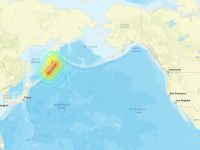The United States Senate Select Committee on Intelligence has asked the Intelligence Community to produce annual reports on the latest intelligence on ballistic missile developments and threats as well as data on non-missile threats throughout the world.
The report, which was recently presented to the Senate, is an unclassified summary of the National Intelligence Estimate (NIE), which was prepared under the auspices of the National Intelligence Officer for Strategic and Nuclear Programs.
The NIE describes new missile developments and the Intelligence Community’s projections of possible ballistic missile threats to the United States and its interests overseas, as well as military forces or allies through the year 2015.
In it are various assessments of theater ballistic missile forces worldwide; evolving proliferation environments and data on forward-based threats and cruise missiles. In addition, the report examines future ballistic missile capabilities of several countries that have ballistic missiles as well as ballistic missile development programs.
Syria
Regarding Syria, the report says that it “remains concerned about Syria’s intentions regarding nuclear weapons”. It adds that "Syria maintains a ballistic missile and rocket force of hundreds of FROG rockets, Scuds, and SS-21 SRBMs. With considerable foreign assistance, Syria progressed to Scud production using primarily locally manufactured parts. Syrian regional concerns may lead Damascus to seek a longer range ballistic missile capability such as North Korea's No Dong MRBM” (medium range ballistic missile).
Iraq
With regards to Iraq, according to the CIA report, the Intelligence community believes that “Baghdad’s goal of becoming the predominant regional power and its hostile relations with many of its neighbors are the key drivers behind Iraq’s ballistic missile program. Iraq has been able to maintain the infrastructure and expertise necessary to develop missiles”.
In addition, it "believes Iraq has retained a small, covert force of Scud-type missiles, launchers, and Scud-specific production equipment and support apparatus. For the next several years at least, Iraq's ballistic missile initiatives probably will focus on reconstituting its pre-Gulf war capabilities to threaten regional targets."
With significant foreign aid “Baghdad could flight-test a domestic mid-range missile by the middle of the decade," says the report, explaining that without international monitoring, and with help from Russia, China and North Korea, Iraq could renew its capabilities as they existed in before the Gulf War. New, liquid fuel al-Samud missiles, with ranges up to 150 kilometers, will soon be deployed in Iraq, and Baghdad could extend their range, according to the report. “Iraq has admitted to having biological and chemical weapons programs before the Gulf war and maintains those programs”.
Iran
According to the National Intelligence Estimate, “Iran is pursuing short and long range missile capabilities”. The Iranian-developed Shahab-3 MRBM, with its 1,300 kilometer range, based on the North Korean No Dong missile, is in advanced stages of development, and Iran could launch it in a conflict. The American intelligence community says that Iran still does not have nuclear capability, but could have one by the end of the decade - or sooner, if it gets foreign assistance. “Meanwhile, Iran is expanding its efforts to sell missile technology”, the report adds.
Libya
The Intelligence community also closely watches Libya. The report claims that “the imposition of UN sanctions has impeded Libyan efforts to obtain foreign assistance for its longer range missile programs. Nevertheless, even if Libya were to obtain a No Dong-class MRBM, Tripoli would be likely to continue to try for longer range systems to increase the number of US and NATO targets it can hold at risk. If a missile were offered with range sufficient to strike 2,500 kilometers into Europe, Libya would try to obtain it”.
The report assesses that Libya has “biological and chemical weapons programs. Libya would need significant foreign assistance to acquire a nuclear weapon, but Tripoli’s nuclear infrastructure enhancements remain of concern. Libya’s missile program depends on foreign support, without which the program eventually would grind to a halt”. (Albawaba.com)
© 2002 Al Bawaba (www.albawaba.com)







